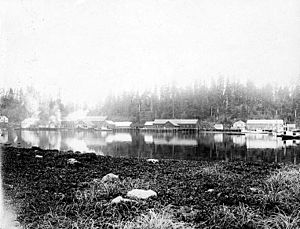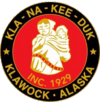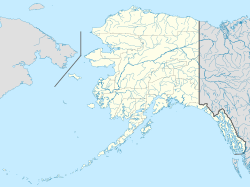Klawock, Alaska facts for kids
Quick facts for kids
Klawock
Lawáak
|
||
|---|---|---|

North Pacific Trading and Packing cannery in Klawak, early 20th century
|
||
|
||
| Nickname(s):
Site of the First Salmon Cannery in Alaska
|
||
| Motto(s):
kla-na-kee-duk
|
||
| Country | United States | |
| State | Alaska | |
| Borough | Unorganized | |
| Census area | Prince of Wales–Hyder | |
| Founded | 1868 | |
| Incorporated | October 29, 1929 | |
| Area | ||
| • Total | 0.97 sq mi (2.52 km2) | |
| • Land | 0.68 sq mi (1.76 km2) | |
| • Water | 0.29 sq mi (0.75 km2) 34.83% | |
| Elevation | 79 ft (24 m) | |
| Population
(2020)
|
||
| • Total | 720 | |
| • Density | 1,057.27/sq mi (408.32/km2) | |
| Time zone | UTC-9 (AKST) | |
| • Summer (DST) | UTC-8 (AKDT) | |
| Zip code |
99925
|
|
| Area code | 907 | |
| FIPS code | 02-40400 | |
| GNIS feature ID | 1423100 | |
Klawock (which means Lawáak in the Tlingit language) is a city in Alaska, a state in the United States. It is located on the west side of Prince of Wales Island. Klawock is found on Klawock Inlet, right across from Klawock Island.
In 2010, about 755 people lived in Klawock. This was a bit less than the 854 people who lived there in 2000. The city is about 90 kilometers (56 miles) from Ketchikan and 11 kilometers (7 miles) from Craig.
Contents
History of Klawock
Klawock was first settled by the Tlingit people. They came from a northern winter village called Tuxekan. The Tlingit used Klawock as a summer fishing camp. They called it by different names like Klawerak and Tlevak. The name "Klawock" comes from the Tlingit name Lawá, who was the person who started the community.
In 1868, people from Europe and America set up a trading post and a place to salt salmon. Later, in 1878, a company from San Francisco opened the very first cannery in Alaska. A cannery is a factory where food, like salmon, is put into cans to preserve it. More canneries were built in the years that followed. A United States post office was opened in Klawock in 1882. By 1890, the town had 260 residents.
Working for Civil Rights
The Alaska Native Brotherhood (ANB) and Alaska Native Sisterhood (ANS) were started in Klawock in 1912. These are groups that work for the civil rights of Alaska Natives. Civil rights are the basic rights and freedoms that all people should have. The people who started these groups and many volunteers helped build the Town Hall and a community center in 1939. This was during the Great Depression, a time when many people had little money or work.
In 1929, Klawock officially became a city. In 1934, the U.S. government gave money to make the cannery bigger. This money came with a rule: the community had to stay liquor-free. At the same time, the Klawock Cooperative Association was formed to manage the cannery. A cooperative association is a group of people who work together for a common goal.
In 2015, a totem pole that had been taken from the old village of Tuxekan in 1931 was returned to the Tlingit people.
Geography and Climate
Klawock is located at 55°33′18″N 133°05′07″W. The city covers about 2.5 square kilometers (0.97 square miles). Most of this area is land, but about 35% is water.
Klawock's Climate
Klawock has a mild oceanic climate. This means it has cool, wet winters and mild summers.
| Climate data for Klawock, Alaska (Klawock Airport), 1991–2020 normals, extremes 1997–present | |||||||||||||
|---|---|---|---|---|---|---|---|---|---|---|---|---|---|
| Month | Jan | Feb | Mar | Apr | May | Jun | Jul | Aug | Sep | Oct | Nov | Dec | Year |
| Record high °F (°C) | 64 (18) |
58 (14) |
71 (22) |
81 (27) |
86 (30) |
92 (33) |
94 (34) |
84 (29) |
83 (28) |
68 (20) |
59 (15) |
66 (19) |
94 (34) |
| Mean maximum °F (°C) | 51.2 (10.7) |
51.4 (10.8) |
56.2 (13.4) |
62.7 (17.1) |
73.5 (23.1) |
74.0 (23.3) |
74.1 (23.4) |
73.7 (23.2) |
72.3 (22.4) |
61.3 (16.3) |
52.1 (11.2) |
50.0 (10.0) |
80.0 (26.7) |
| Mean daily maximum °F (°C) | 39.5 (4.2) |
41.3 (5.2) |
44.3 (6.8) |
50.7 (10.4) |
56.8 (13.8) |
60.5 (15.8) |
63.1 (17.3) |
64.3 (17.9) |
59.8 (15.4) |
51.7 (10.9) |
43.5 (6.4) |
40.1 (4.5) |
51.3 (10.7) |
| Daily mean °F (°C) | 35.3 (1.8) |
35.9 (2.2) |
37.8 (3.2) |
42.9 (6.1) |
49.0 (9.4) |
53.4 (11.9) |
56.9 (13.8) |
57.5 (14.2) |
53.3 (11.8) |
45.7 (7.6) |
38.9 (3.8) |
35.7 (2.1) |
45.2 (7.3) |
| Mean daily minimum °F (°C) | 31.1 (−0.5) |
30.4 (−0.9) |
31.4 (−0.3) |
35.2 (1.8) |
41.1 (5.1) |
46.4 (8.0) |
50.6 (10.3) |
50.6 (10.3) |
46.8 (8.2) |
39.7 (4.3) |
34.3 (1.3) |
31.4 (−0.3) |
39.1 (3.9) |
| Mean minimum °F (°C) | 16.8 (−8.4) |
17.6 (−8.0) |
19.7 (−6.8) |
26.9 (−2.8) |
32.5 (0.3) |
39.0 (3.9) |
44.8 (7.1) |
44.9 (7.2) |
36.5 (2.5) |
29.9 (−1.2) |
22.3 (−5.4) |
19.1 (−7.2) |
12.1 (−11.1) |
| Record low °F (°C) | −11 (−24) |
−9 (−23) |
−6 (−21) |
10 (−12) |
27 (−3) |
33 (1) |
39 (4) |
37 (3) |
27 (−3) |
2 (−17) |
−4 (−20) |
−3 (−19) |
−11 (−24) |
| Average precipitation inches (mm) | 8.65 (220) |
6.33 (161) |
6.82 (173) |
5.51 (140) |
4.10 (104) |
3.41 (87) |
4.27 (108) |
6.79 (172) |
10.72 (272) |
12.33 (313) |
10.17 (258) |
10.10 (257) |
89.20 (2,266) |
| Average precipitation days (≥ 0.01 in) | 22.4 | 17.7 | 21.1 | 19.8 | 18.2 | 17.5 | 18.5 | 19.1 | 21.5 | 23.6 | 22.9 | 22.2 | 244.5 |
| Source 1: NOAA | |||||||||||||
| Source 2: National Weather Service (mean maxima/minima 2006–2020) | |||||||||||||
Population of Klawock
| Historical population | |||
|---|---|---|---|
| Census | Pop. | %± | |
| 1880 | 27 | — | |
| 1890 | 287 | 963.0% | |
| 1900 | 131 | −54.4% | |
| 1910 | 241 | 84.0% | |
| 1920 | 19 | −92.1% | |
| 1930 | 437 | 2,200.0% | |
| 1940 | 455 | 4.1% | |
| 1950 | 404 | −11.2% | |
| 1960 | 251 | −37.9% | |
| 1970 | 213 | −15.1% | |
| 1980 | 318 | 49.3% | |
| 1990 | 722 | 127.0% | |
| 2000 | 854 | 18.3% | |
| 2010 | 755 | −11.6% | |
| 2020 | 720 | −4.6% | |
| U.S. Decennial Census | |||
Klawock first appeared in the U.S. Census in 1880. It was listed as the Tlingit village of "Klawak." The spelling "Klawock" started appearing in 1910 and became official in 1920. The town was officially incorporated as a city in 1929.
In 2000, Klawock had 854 people living in 313 households. About half of the people were Native American (50.94%), and about 41% were White. About 36% of households had children under 18 living there. The average age of people in Klawock was 34 years old.
Things to Do in Klawock
Klawock is home to Alaska's oldest hatchery. A hatchery is a place where young fish are raised. This hatchery helps increase the number of salmon, like sockeye and coho, and steelhead trout in the area. There is also a sawmill and logging operations here.
Klawock has a harbor that tourists often use. It's a great starting point for boat trips to explore the nearby bays, inlets, and islands.
Local Celebrations
Every year on February 16, the ANB and ANS groups hold the "Elizabeth Peratrovich Celebration." This event honors the day a very important law against discrimination was passed. Discrimination is when people are treated unfairly because of who they are. The city also hosts a summer festival called "Celebration by the Sea."
Totem Park
Klawock has a special Totem Park with 21 totem poles. This is one of the biggest collections in Alaska. These totem poles include both original and copied poles from the old village of Tuxekan. The city built a carving shed where the poles are restored, and visitors can watch the work. In 1998, the city also built a traditional Long House, called Gaanì Ax Adi, and added a new totem pole to it.
Education in Klawock
Klawock has a school for students in kindergarten through 6th grade. There is also a high school for grades 7 through 12. Both schools are part of the Klawock City School District. Around 200 students attend these schools each year. For younger children (ages three to four), there is a Head Start program. This program is run by the Tlingit and Haida Central Council.
Getting Around Klawock
Airport
The Klawock Airport has a 5,000-foot paved runway. It is the only airport on Prince of Wales Island. It serves as the main way to travel by air for nearby Craig as well. You can find charter flights and daily scheduled passenger flights from Ketchikan through Island Air Express. Alaska Seaplanes also offers flights from Juneau and Sitka.
Ferry Service
You can also reach Klawock by ferry. The Inter-Island Ferry Authority provides service from two communities on Prince of Wales Island:
- Hollis: The M/V Prince of Wales ferry travels to Ketchikan from here.
- Coffman Cove: The M/V Stikine ferry travels to Wrangell or Petersburg from here.
Both Hollis and Coffman Cove can be reached by Klawock's road system.
Cruise Ships
A new port for cruise ships opened in Klawock in May 2024. The first ship to visit was the Seabourn Odyssey. This port is owned and operated by companies belonging to the Tlingit people.
Notable People from Klawock
- Frank Peratrovich (1895–1984): He was the mayor of Klawock and later became the president of the ANB. He was also one of the 55 people who helped write the Alaska Constitution in 1955.
- Elizabeth Peratrovich (1911–1958): She was Frank's sister-in-law and the president of the Alaska Native Sisterhood (ANS). In the 1940s, she worked hard to pass laws against discrimination. She is famous for her powerful speech in 1945 that helped the Alaska Senate approve an important anti-discrimination law. Alaska honors her contributions by naming February 16 and a gallery in the State Capitol after her.
See also
 In Spanish: Klawock (Alaska) para niños
In Spanish: Klawock (Alaska) para niños



